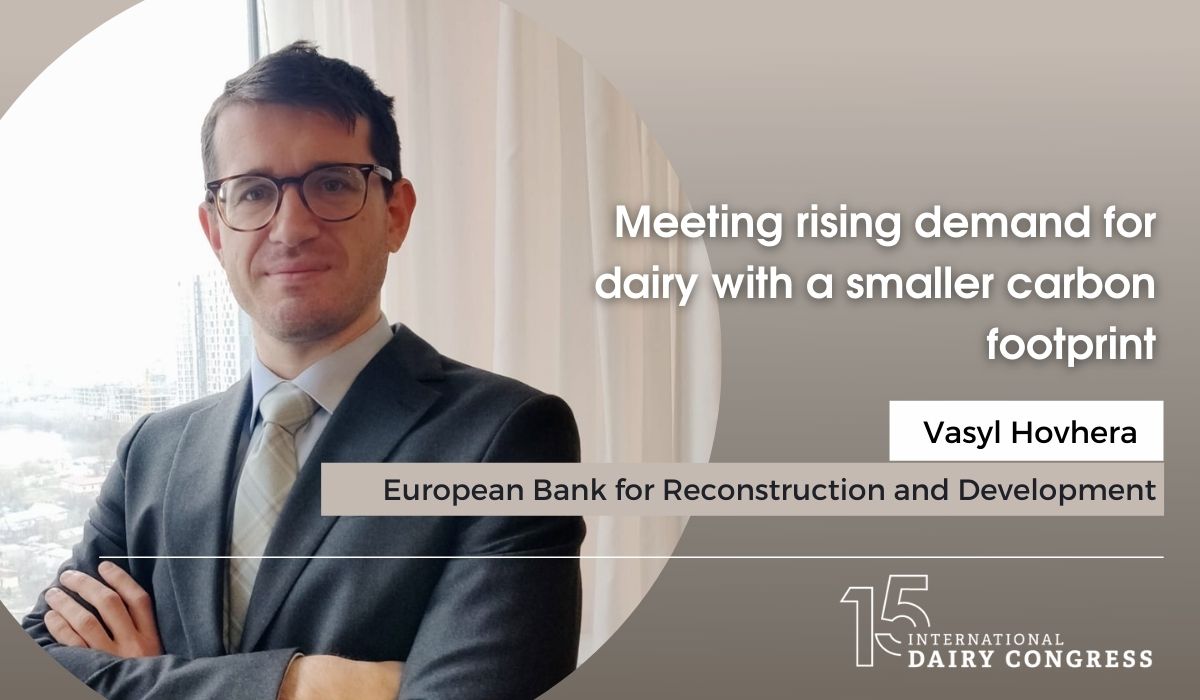Global demand for dairy products is rising fast, meaning milk production must grow fast as well. However, the dairy industry has a large carbon footprint so investing in productivity and resource efficiency is fundamental to mitigate the greenhouse gas emissions from increased milk production.
Vasyl Hovhera, Lead Expert, Agribusiness Department, European Bank for Reconstruction and Development (EBRD), talks about this in more detail.
As the world’s population increases, so does the demand for food. According to forecasting by the Organisation for Economic Co-operation and Development and the Food and Agricultural Organization (OECD-FAO),[1] global per-capita consumption of fresh dairy products is projected to increase by 1.2 per cent a year, driven by income growth across the world. In developed countries, per-capita consumption of dairy will grow from 23.6 kg in 2018-20 to 25.2 kg in 2030, and from 10.7 kg to 12.6 kg in developing countries.
This higher per-capita consumption of dairy products, coupled with world population growth, will drive up global demand for dairy. And to meet this demand, milk production will have to increase by 1.7 per cent a year over the forecast period, reaching more than 1 billion tonnes in 2030.

To increase milk production, two factors are key: the number of animals (inventory) and their productivity (milk yield per animal). The number of dairy animals is expected to rise globally by 1.1 per cent a year while average milk yield per animal will increase by just 0.7 per cent. Therefore, an expanding livestock inventory is expected to outperform productivity. This is because most of the growth in milk production is expected to be in India, Pakistan and across Africa, where productivity of milk production is low.
But with higher agricultural output comes a bigger carbon footprint
According to the Intergovernmental Panel on Climate Change,[1] between 2007 and 2016 almost a quarter of global anthropogenic greenhouse gas (GHG) emissions came from agriculture, forestry and other land uses, with cattle breeding contributing the most. According to forecasting by OECD-FAO, a rise in agricultural production is expected to lead to a 4 per cent increase in the sector’s GHG emissions by 2030, and that livestock will account for 80 per cent of this. Nevertheless, growth in gross outputs will significantly outpace growth in direct GHG emissions, leading to lower GHG intensity (GHG emissions per unit of output) in agriculture.

The GHG intensity in agriculture can be reduced by making agricultural practices more productive and resource-efficient but due to existing gaps in technological advancement, regions are expected to perform differently.
According to the OECD-FAO, in Asia Pacific, the Near East and North Africa[1], significant rises in agricultural production will contribute to a much lower increase in GHG emissions, suggesting that improvements in resource efficiency and lower GHG intensity will help mitigate a rise in emissions from increased agricultural production. This is also the case in Europe, Central Asia, North America and Latin America and the Caribbean, where the growth of agricultural production will be sustained with almost no increase in total GHG emissions. In Sub-Saharan Africa a rise in agricultural production will lead to an almost equivalent growth rate of GHG emissions, suggesting that the region needs to increase productivity and resource efficiency.

Growing consumer concerns about the environmental effects of livestock farming will inevitably have an impact on the future of the dairy sector. Consumers are increasingly interested in vegan or flexitarian diets and products made from "alternative", plant-based proteins that mimic animal products. According to Mintel[1], in 2021 a record one in three Britons and almost half of those aged 25 to 44 were consumers of plant milk. As the supply of "alternative", plant-based products grows every year, their cost decreases and the choice for consumers becomes more and more diverse. Vegetable milk based on soy, almonds, coconut, oats, rice and hemp or other nuts are popular, as are vegetable yogurt and tofu cheese. Nevertheless, the skyrocketing growth of alternative protein markets is not enough to curb the demand for conventional dairy.
In this context, reducing GHG intensity is fundamental to promote more sustainable milk production. This is particularly the case for countries with significant performance gaps. According to FAO estimates,[2] in 2015 GHG emission intensities ranged from 1.3 kg of CO₂ equivalent per kg of milk[3] in countries with more advanced production systems, to 6.7 kg of CO₂ equivalent per kg of milk in countries with less advanced systems. To close this gap, however, one must know how to measure it.
GHG emissions from milk production can be estimated using the Global Environmental Assessment Model (GLEAM), which was developed by FAO and is freely available. In line with the life cycle assessment principle, GLEAM models biophysical processes and activities along livestock supply chains, quantifies the production and use of natural resources, and determines the environmental impact of animal husbandry. The online version of the calculator model (GLEAM-i)[1] allows the user to self-estimate GHG emissions at the farm or at individual investment project level. The model can also contribute to the development of a national greenhouse gas inventory or a national defined contribution.
To reduce the GHG intensity of milk production, the industry needs to invest in technology, and improve productivity and resource efficiency. This can be done through better production management systems, improved animal health, feeding practices and genetics, modern manure management and methane capture technologies, and optimised (localised) supply chains.
To remain competitive, the dairy sector should keep its carbon footprint as small as possible by identifying and filling the performance gaps and by investing in GHG reduction measures to sustainably satisfy the demand that we know is coming.
Discussions with Vasyl Hovhera will continue during the 15th International Dairy Congress on February 28 - March 1 as part of the discussion round "Energy Independence of Ukraine" (KyivExpoPlaza, 1 Amsterdam Street, Berezivka, Kyiv region). Moderator: Hanna Lavreniuk, Director General of the Association of Milk Producers. In addition, we will consider the practical experience of implementing energy efficient technologies of Ukrainian and American enterprises.
Welcome! Registration for the congress by link or by phone 0674705563.
Press service of the Association of Milk Producers
[1] OECD/FAO (2021), OECD-FAO Agricultural Outlook 2021-2030, OECD Publishing, Paris, https://doi.org/10.1787/19428846-en.
[2] IPCC (2019), Climate Change and Land: an IPCC special report on climate change, desertification, land degradation, sustainable land management, food security, and greenhouse gas fluxes in terrestrial ecosystems https://www.ipcc.ch/srccl/.
[3] According to OECD-FAO the Near East and North Africa region includes Egypt, Iran (Islamic Republic of), Saudi Arabia, Mauritania, Sudan, Algeria, Libya, Morocco, Tunisia, Bahrain, Iraq, Jordan, Kuwait, Lebanon, Occupied Palestinian Territory, Oman, Qatar, Syrian Arab Republic, United Arab Emirates and Yemen
[4] https://www.mintel.com/press-centre/food-and-drink/the-cream-of-the-vegan-milk-crop-sales-of-oat-milk-overtake-almond-in-the-uk
[5] FAO and GDP (2018), Climate change and the global dairy cattle sector – The role of the dairy sector in a low-carbon future, https://www.fao.org/3/CA2929EN/ca2929en.pdf.
[6] With fat and protein content adjustment.


